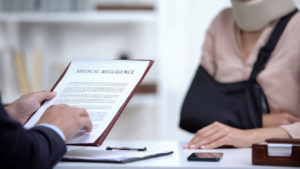Just as living vicariously through someone else involves taking pleasure in another person’s exploits, vicarious liability means that you can legally be held responsible for another person’s wrongdoing. This is possible because of how certain legal relationships work. Should an employee forget to put out a “wet floor” sign after mopping up a spill, a customer may slip on the wet patch and, If the fall leads to an injury, the customer could sue your business for damages. Even though your employee’s actions led to the incident (and even if you reminded the employee to put up the sign), you and your business could be considered responsible in the eyes of the law.
As a business owner could be vicariously liable for the actions their employees. In order for liability to pass from an employee to you or your business, the employee must be acting within the scope of their job or professional duties. Even if an employee acts against directions you give them, you could be held liable for the damage their action (or lack of action) causes.
This involves showing that the driver who was at fault was acting in the course and scope of their employment when delivering a pizza for his employer, so vicarious liability probably would apply. If the driver was visiting a friend on his way home from work, this would be a personal errand, so the employer probably would not be liable. Whether the employee was using their own car does not affect the question of whether vicarious liability applies.
A doctrine known as the “going and coming rule” generally prevents employers from being vicariously liable for accidents caused by employees while they are commuting to and from work. Also, employees are not considered to be on the job while they are using their lunch break to handle personal matters. Situations that mix business with personal errands, however, may expose an employer to liability. An accident victim should consult an attorney to find out whether vicarious liability may apply.
Vicarious liability is a legal doctrine that assigns liability for an injury to a person who did not cause the injury but who has a particular legal relationship to the person who did act negligently. It is also referred to as imputed negligence. Legal relationships that can lead to imputed negligence include the relationship between parent and child, husband and wife, owner of a vehicle and driver, and employer and employee. Ordinarily the independent negligence of one person is not imputable to another person.
The employer is charged with legal responsibility for the negligence of the employee because the employee is held to be an agent of the employer. If a negligent act is committed by an employee acting within the general scope of her or his employment, the employer will be held liable for damages. For example, if the driver of a gasoline delivery truck runs a red light on the way to a gas station and strikes another car, causing injury, the gasoline delivery company will be responsible for the damages if the driver is found to be negligent. Because the company will automatically be found liable if the driver is negligent, respondent superior is a form of strict liability.
Another common example of imputed negligence is attributing liability to the owner of a car, where the driver of the car committed a negligent act. This type of relationship has been labeled the family car doctrine. The doctrine is based on the assumption that the head of the household provides a car for the family’s use and, therefore, the operator of the car acts as an agent of the owner. When, for example, a child drives a car, registered to a parent, for a family purpose, the parent is responsible for the negligent acts of the child at the wheel.
Liability can also be imputed to an owner of a car who lends it to a friend. Again, the driver of the car is acting as the agent of the owner. If the owner is injured by the driver’s negligence and sues the driver, the owner can lose the lawsuit because the negligence of the driver can be imputed to the owner, thereby rendering him contributorily negligent. This concept is known as imputed contributory negligence.
Remember, each case is unique, so contact HURT-511 for more information on workers’ comp statute and our personal injury lawyers help injured workers recover the benefits to which they are entitled by law. For a free consultation with an experienced workers’ compensation lawyer, call us toll-free at 800-4878-511 or complete our online form. Our firm handles accident and injury claims throughout all five boroughs of New York.
HURT-511 operates in all boroughs of New York including all Bronx neighborhoods, namely: Bedford Park, Belmont, Fordham, Highbridge, Hunts Point, Jerome Park, Kingsbridge, Morris Park, Morrisania, Mott Haven, Parkchester, Riverdale, Spuyten Duyvil, Throgs Neck, University Heights and Woodlawn.





 Trusted Reviews
Trusted Reviews



